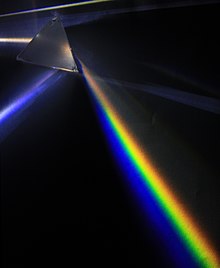
Back Sigbare spektrum Afrikaans طيف مرئي Arabic Espectru visible AST Бачнае выпраменьванне Byelorussian Бачнае выпраменьваньне BE-X-OLD Видим спектър Bulgarian দৃশ্যমান বর্ণালী Bengali/Bangla Spektr gwelus Breton Vidljiva svjetlost BS Espectre visible Catalan

The visible spectrum is the band of the electromagnetic spectrum that is visible to the human eye. Electromagnetic radiation in this range of wavelengths is called visible light (or simply light). The optical spectrum is sometimes considered to be the same as the visible spectrum, but some authors define the term more broadly, to include the ultraviolet and infrared parts of the electromagnetic spectrum as well, known collectively as optical radiation.[1][2]
A typical human eye will respond to wavelengths from about 380 to about 750 nanometers.[3] In terms of frequency, this corresponds to a band in the vicinity of 400–790 terahertz. These boundaries are not sharply defined and may vary per individual.[4] Under optimal conditions, these limits of human perception can extend to 310 nm (ultraviolet) and 1100 nm (near infrared).[5][6][7]
The spectrum does not contain all the colors that the human visual system can distinguish. Unsaturated colors such as pink, or purple variations like magenta, for example, are absent because they can only be made from a mix of multiple wavelengths. Colors containing only one wavelength are also called pure colors or spectral colors.[8][9]
Visible wavelengths pass largely unattenuated through the Earth's atmosphere via the "optical window" region of the electromagnetic spectrum. An example of this phenomenon is when clean air scatters blue light more than red light, and so the midday sky appears blue (apart from the area around the Sun which appears white because the light is not scattered as much). The optical window is also referred to as the "visible window" because it overlaps the human visible response spectrum. The near infrared (NIR) window lies just out of the human vision, as well as the medium wavelength infrared (MWIR) window, and the long-wavelength or far-infrared (LWIR or FIR) window, although other animals may perceive them.[2][4]
- ^ Pedrotti, Frank L.; Pedrotti, Leno M.; Pedrotti, Leno S. (December 21, 2017). Introduction to Optics. Cambridge University Press. pp. 7–8. ISBN 9781108428262.
- ^ a b "What Is the Visible Light Spectrum?". ThoughtCo. Archived from the original on 2024-09-18. Retrieved 2024-10-04.
- ^ Starr, Cecie (2005). Biology: Concepts and Applications. Thomson Brooks/Cole. p. 94. ISBN 978-0-534-46226-0.
- ^ a b "The visible spectrum". Britannica. 27 May 2024. Archived from the original on 12 July 2022. Retrieved 13 January 2021.
- ^ D. H. Sliney (February 2016). "What is light? The visible spectrum and beyond". Eye. 30 (2): 222–229. doi:10.1038/eye.2015.252. ISSN 1476-5454. PMC 4763133. PMID 26768917.
- ^ W. C. Livingston (2001). Color and light in nature (2nd ed.). Cambridge, UK: Cambridge University Press. ISBN 0-521-77284-2. Archived from the original on 2024-10-04. Retrieved 2021-03-05.
- ^ Grazyna Palczewska; et al. (December 2014). "Human infrared vision is triggered by two-photon chromophore isomerization". Proceedings of the National Academy of Sciences. 111 (50): E5445 – E5454. Bibcode:2014PNAS..111E5445P. doi:10.1073/pnas.1410162111. PMC 4273384. PMID 25453064.
- ^ Nave, R. "Spectral Colors". Hyperphysics. Archived from the original on 2017-10-27. Retrieved 2022-05-11.
- ^ "Colour - Visible Spectrum, Wavelengths, Hues | Britannica". www.britannica.com. 2024-09-10. Archived from the original on 2022-07-12. Retrieved 2024-10-04.